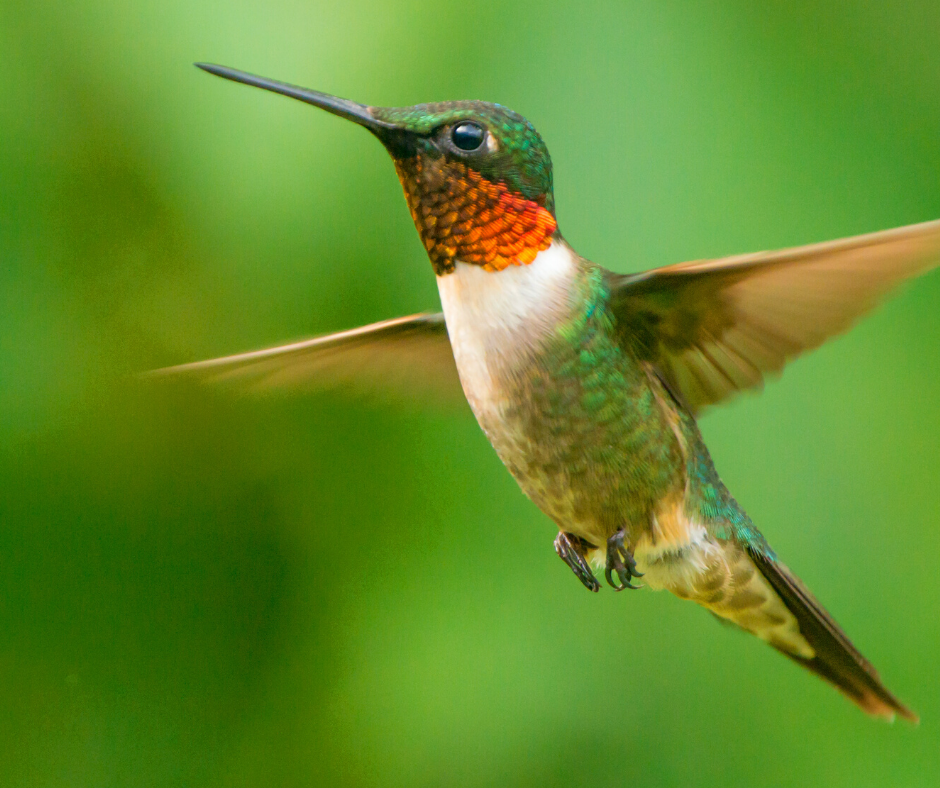
By Tabitha Evans Moore | Editor & Publisher
It’s Saturday and I’m minding my own business … sipping coffee on my patio … my red hair stacked on top of my head in a messy bun. Suddenly, I’m buzzed by two tiny red-throated Jedi. I’m not sure if it’s the two feeders full of sugar water I put out the night before, the new red petunia hanging basket, or the hair, but I’ve apparently created a hummingbird paradise right here in Moore County.
One sits on the feeder and sips for a moment before the other one dive bombs him from above. The first retreats and then hovers around my new petunia before getting run off again. At one point, I can sense (but not see) the two little guys facing off on either side of my hair.
“They think you’re the mother ship,” my friend laughs before going back to his crossword.
Spring means hummingbirds return to middle Tennessee
It’s entertaining behavior for sure, but not unusual. It’s spring in southern, middle Tennessee and the Ruby-Throated Hummingbirds don’t have time to mess around. They’ve just flown 600 miles from southern Mexico. It’s a tough trip across the Gulf of Mexico that, even in ideal conditions, can take 18-20 hours … their tiny wings beating an average of 53 times a second, continuously the whole way. You really can’t blame them for being cranky and hungry when they arrive.
Hummingbirds are small (measuring just three and three quarters inches long) but they don’t seem to know it. Two males, like the ones fighting over my patio, will staunchly defend what they consider to be “their” territory. A single male hummingbird will attempt to defend up to a quarter acre at a time.
The Ruby-Throated variety are the only hummingbirds that breed in eastern North America and often the only variety you’ll see east of the Mississippi.
They swarm into southern, middle Tennessee around April 1 with loving on their mind. Now, it’s time to find a nest, find a mate, and get to making their happy, little bird families. And to do this they’ll need energy. This is where you come in. Nectar, like that found naturally in blooming spring flowers or placed artificially by you in feeders, helps the hummingbird replenish the energy zapped by the long flight in.
Feeders and red flowers attract birds
In order to attract hummingbirds to your yard, it’s often a good idea to hang multiple feeders filled with a simple nectar made from one-part white table sugar and four parts water. Avoid store bought nectars that add artificial red dyes, as these can be harmful to the birds. Bright red objects do attract them though, so hanging plants with bright, red blooms also helps.
Most experts recommend changing the sugar water every three days and cleaning the feeders once a weak with a diluted white vinegar solution. If you see signs of black mold, clean the feeder immediately but never use soap.
Most hummingbirds leave again in the fall, usually around October, but some can stay all winter. People often take down their feeders early out of a fear that the hummingbirds will stay too long and die in the harsh winter if artificially feed. But that’s an old wives’ tale. Hummingbirds only use nectar for stored energy. They’re actually carnivores who subsist on small insects. They’ll depart for Mexico when their food source goes away or their tiny internal clocks tell them it’s time to migrate … with or without an available feeder. Homeowners should remove feeders from their yard when they stop seeing hummingbird activity, according to the UT Institute of Agriculture. For more information, check out their Hummingbird Gardening in Tennessee guide by clicking here. •
{The Lynchburg Times is the only locally owned newspaper in Lynchburg and also the only woman-owned newspaper in Tennessee. We cover Metro Moore County government, Jack Daniel’s Distillery, Nearest Green Distillery, Tims Ford State Park, Motlow State Community College, Moore County High School, Moore County Middle School, Lynchburg Elementary, Raider Sports, plus regional and state news.}
